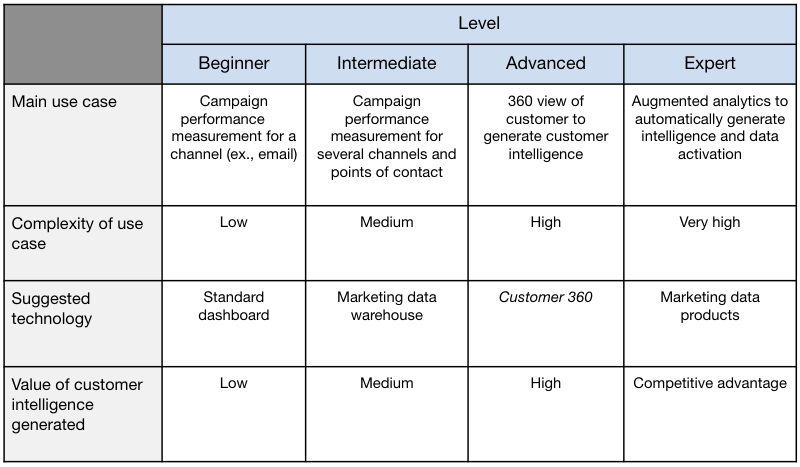Vice-President Data & Customer Experience, Partner
Data, the beating heart of relationship marketing
Vice-President Data & Customer Experience, Partner
Let’s start with a simple and almost naive question:
Is it still possible in 2023 to invest in relationship marketing without relying on data?
The answer is probably yes, but not if you want to see a positive return on investment on the campaigns and projects you launch.
In 2023, it’s extremely difficult to be successful in relationship marketing (and marketing in general) without having a good understanding of your customers, which necessitates that a company be able to access data. Given data is what guides the creation and implementation of strategies, optimizing data collection is nothing less than the axis around which the entire field is rotating.
Basically, in relationship marketing, the data ecosystem allows companies to:
1. better understand its customers;
2. segment customers; and
3. accelerate the activation of segments through technology.
Now that we’ve laid out the basics, let’s focus on two central aspects of a successful relationship marketing program: understanding and segmenting your customers.
Understanding your customers better
Understanding your customer means first and foremost becoming familiar with them, learning more about what motivates them, their needs and budgets, as well as the relationship they have with your company. To arrive at such an understanding, you can start by answering the following questions:
- Who is our target customer?
- How does this person interact with the brand?
- How does this person use our products and/or services?
- How much on average does this person spend?
- What factors influence their level of satisfaction with and loyalty to the brand?
- Why does this person choose our brand instead of another one?
Understanding the customer’s behaviour and the motivations underlying this behaviour is essential to developing relationship marketing strategies that are targeted, relevant and effective.
In order to obtain reliable information about your customers, you need to combine three types of data: behavioural, transactional and attitudinal (individual needs and motivations). When available, these socio-demographic data represent an invaluable aid to relationship marketing specialists because they allow the various profile types that make up the company’s client base to be enhanced with complementary information.
Segmenting your customers
For marketers, segmentation is a crucial tool that lets them target their client base or prospects with more precision. Simply put, segmentation is the process of creating sub-groups within a population. These sub-groups are selected based on certain criteria (behavioural, socio-demographic features). When activating strategies or making them operational, segmentation lets you maximize your chances of increasing your marketing return on investment by targeting the groups that are most likely to respond positively to the initiatives you are launching. Identifying valuable customers, personalizing marketing strategies and promotional offers (an important tactic in relationship marketing) and differentiating customer service are just a few of the many advantages effective segmentation offers businesses.
Types of marketing segmentation
The four most popular types of segmentation in marketing (and relationship marketing) are:
- Value segmentation, which groups customers together based on the dollar value of their purchases
- Behavioural segmentation, which groups customers based on their behaviour and use of the products and services
- Socio-demographic segmentation, which groups customers based on their geographic location, sex, age, income, etc.
- Attitudinal segmentation, grouping customers and prospects based on their perception of the brand and their needs.
In reality, modern segmentation uses all of these axes. These are hybrid segmentations maximizing the support provided by each type of segmentation in order to provide a more realistic picture of customer profiles. Propensity attributes (such as the likelihood of making a purchase, unsubscribing, etc.) are often added to segments to make them more usable. Propensity and the probability related to an event, such as a customer with a propensity to make purchases, will be targeted if the business’s goal is to increase the average shopping cart value per customer (logically, customers with a high propensity to buy are more likely to respond favourably to an offer).
Marketing segmentation techniques
Segmentation techniques vary in complexity. Segmentation can be performed using business practices (Ontario customers vs. Quebec customers, client credit cards vs. client chequing accounts, etc.) or by using statistical techniques (factor analysis, cluster analysis, decision trees, latent class analysis, etc.). Choosing the techniques that will work best for each company depends on a number of factors, including the quality of available data, knowledge of the sector and the skills of the internal team (especially those of the analysts and data scientists).
Whichever technique is chosen, certain criteria must always be satisfied to ensure the quality of the results obtained through segmentation. To ensure their quality, the segments produced must be:
Whichever technique is chosen, certain criteria must always be satisfied to ensure the quality of the results obtained through segmentation. To ensure their quality, the segments produced must be:
- easy to differentiate from one another;
- operationalized or activated;
- fairly large in size;
- long-lasting, so they can be used in operations for as long as possible (a segment with a lifespan of only two or three months will cause operational issues); and
- easy to explain and communicate to the rest of your organization.
Facilitating customer insight with technology
In order to know which technology will support your company’s customer intelligence needs, it’s important to identify data use cases as well as your level of operational maturity. The following chart aims to map the combinations of use cases and the technologies supporting them:

Simple dashboard
If the company’s main use case is measuring the performance of campaigns or strategies deployed on a single channel (email, media, SEO, etc.), traditional dashboards or platform reports are usually sufficient. Tools such as Supermetrics can facilitate automated data export to create personalized dashboards from spreadsheets (Google Sheet, Excel). This is the simplest use case. This type of technology is not really focused on customers, but rather on the performance of marketing campaigns. There is no actual customer intelligence.
Marketing data warehouse
After many years of work, a company will often have multiplied its channels and platforms and the types of information it collects. As the amount of data grows (and grows, and grows), its management becomes more difficult and even confusing. Once it becomes critical to unify this mass of stored information, a company will need to create a centralized repository. This tool will allow all the data to be stored under one roof and, at the same time, facilitate 360 performance, which is the performance of marketing initiatives (including relationship marketing) on many channels (online and offline) and advertising platforms (Google, Facebook, Amazon).
Platforms such as Google BigQuery, Snowflake, Amazon Redshift and Azure Synapse let you create mini marketing data warehouses that focus on the marketing domain. Because they are easy to deploy, BigQuery and Snowflake are still the preferred platforms from a marketing perspective.
Customer 360
A 360 perspective is a complete picture of a company’s customer base. Achieved by collecting data created by customers when they access points of contact with the organization, this wider perspective enables the activation of unified profiles to be used for marketing and personalization purposes. Presented in this light, the idea may seem straightforward. But when it comes time to put it into practice, many find they hit a wall.
According to a study from Gartner published in 2022, only 15% of companies that take on this project are able to generate a true 360 view of their customers. And yet the difficulty of pulling off this exercise hasn’t put a damper on organizations’ interest: According to this same study, 82% of organizations aim to give it a try.
In a situation where a company has the goal of achieving a 360 perspective and activating key segments from engagement platforms, it must be able to access more advanced technological solutions that are capable of supporting and collecting the data needed for this purpose. Customer data platforms (CDP) were created explicitly to help companies develop a 360 view of their customers.
Building a Customer 360
As an organization, you can decide to build a Customer 360 directly from your marketing data warehouse. If you opt for this path, your company can combine cloud-based data warehouses (BigQuery, Snowflake, Amazon Redshift) with specialized tools in Reverse ETL (Census, Hightouch) and data integration platforms (Supermetrics, Fivetran, Improvado, Adverity).
Buying a Customer 360
If you choose to buy one, integrated CDPs are available. Among the more popular platforms are notably Segment, Adobe Real-Time CDP, Tealium, Amplitude and Salesforce.
Creating a 360 view of your customer isn’t an easy project. It might be wise to develop a data strategy in order to determine whether the best option for your business would be to build a 360 profile yourself or to buy a CDP created for this purpose.
Marketing data products (augmented analytics)
Generation of marketing insights, recommendations targeting the next best action of the customer, detection of high-value segments, 1:1 personalization... Today, all of this can be achieved with automation thanks to artificial intelligence (AI).
However, you need to keep in mind that this type of technology requires a higher-than-average volume and quality of data, as well as a robust quality assurance process. Marketing data products can be combined with Customer 360 depending on the seller or the maturity of the company.
*
I hope this article has given you an overall understanding of the role data plays in developing a relationship marketing program. Note that it has only skimmed the surface on using certain key technologies in segmentation and the activation of customer profiles.
If you would like to develop a relationship marketing strategy that’s firmly anchored in data analysis or would like recommendations on Customer 360 technology platform options, don’t hesitate to get in touch with us. Our team would be happy to help you achieve your business goals!













